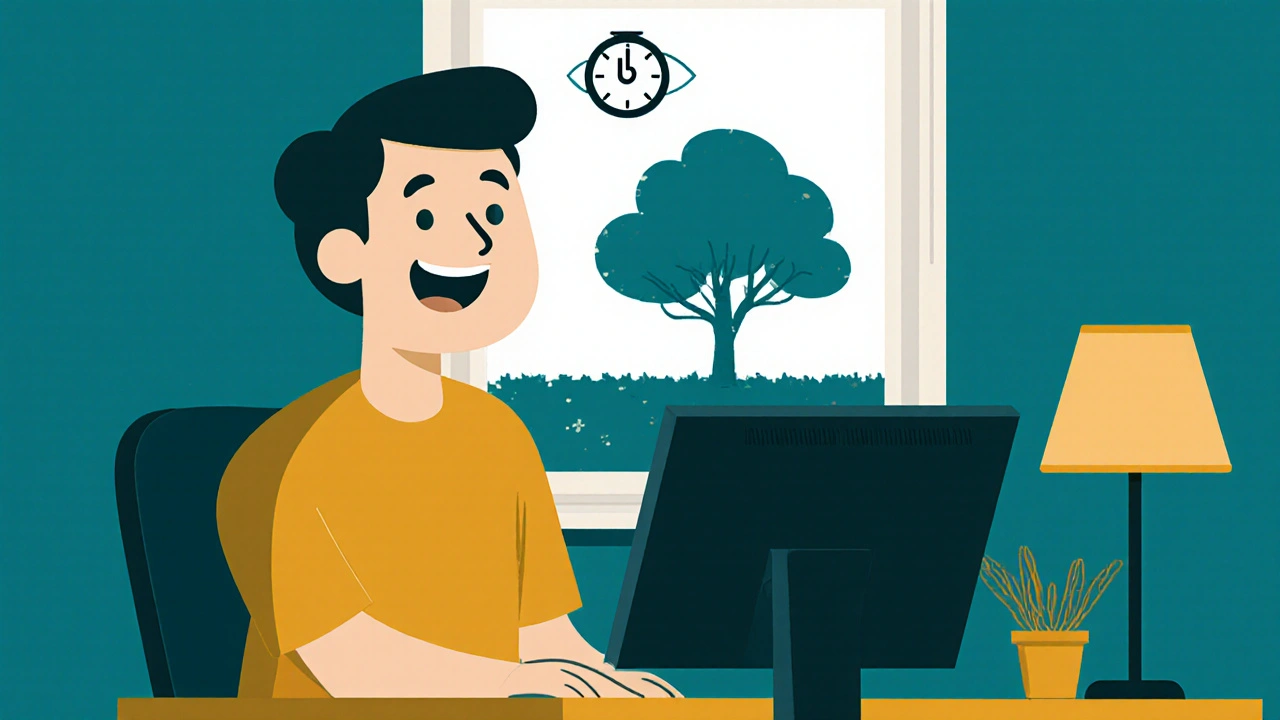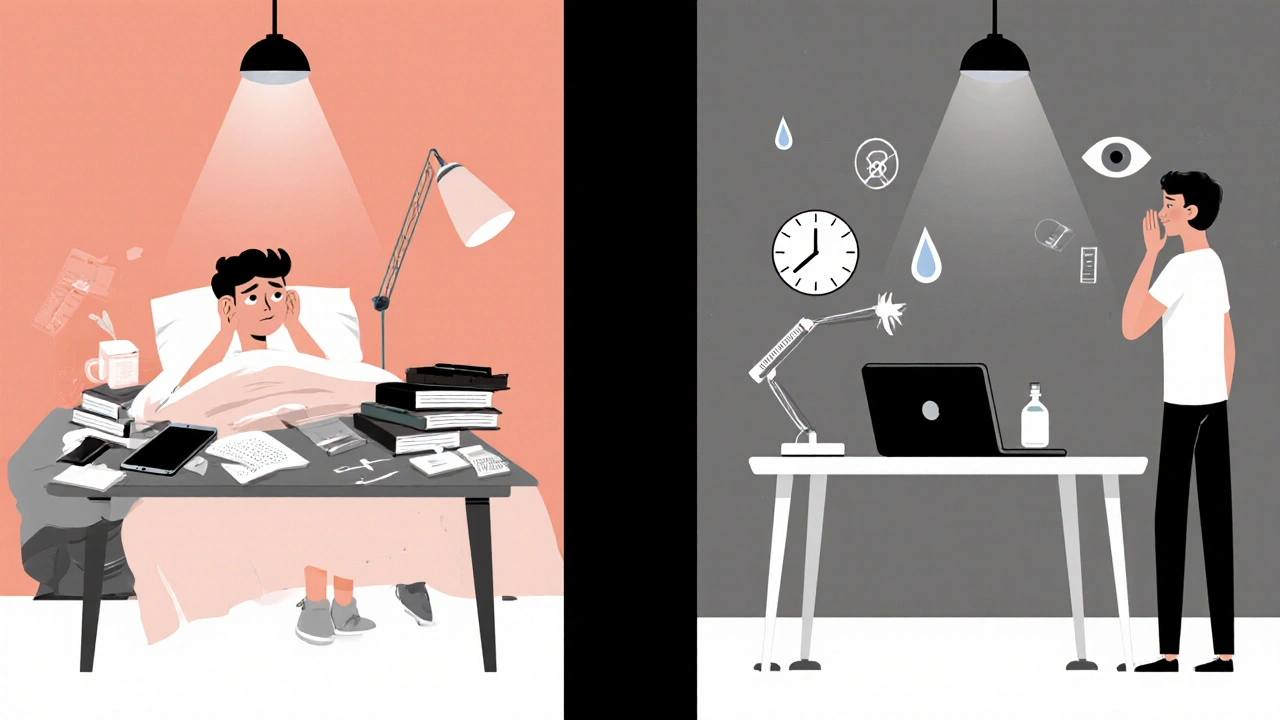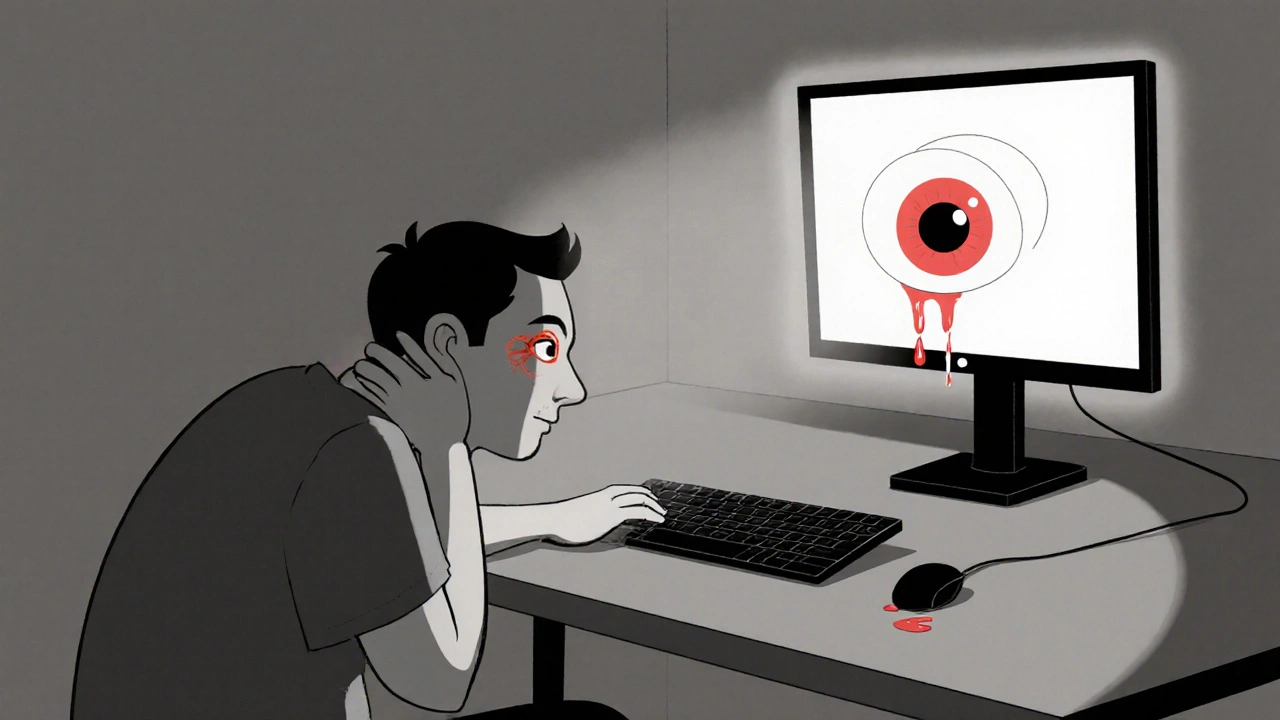By 2025, nearly 75% of people who use digital screens daily will experience digital eye strain. It’s not just tired eyes - it’s headaches that hit by mid-morning, blurry vision after lunch, and neck pain that won’t quit. If you’re staring at a screen for more than two hours straight, you’re not alone. And you’re not imagining the discomfort. This is Computer Vision Syndrome (CVS), a real, measurable condition backed by decades of clinical research.
What Exactly Is Computer Vision Syndrome?
Computer Vision Syndrome isn’t a single problem. It’s a mix of eye and body symptoms caused by prolonged screen use. Your eyes work harder than they should. The characters on screens aren’t as sharp as printed text. The contrast is low. Glare bounces off the surface. And worst of all - you blink less. Studies show your blink rate drops from 15 times a minute to just 5 when you’re focused on a screen. That’s a 66% drop. No wonder your eyes feel dry, gritty, and sore.
Symptoms aren’t just minor annoyances. According to the American Optometric Association, 65% of American adults report at least one symptom. The NIH found 64% of computer users get eye strain, 44% get headaches, and 39% have blurred vision. Neck and shoulder pain? That’s 28% of users. And these aren’t just office workers. Students, remote employees, content creators, and even gamers are affected.
It’s not about being weak or lazy. It’s about how screens hijack your natural vision system. Your eyes are built to focus on things at varying distances. But screens lock your gaze at one fixed point. Your ciliary muscles - the ones that adjust your lens - stay tense. Constantly. That’s like holding a bicep curl for eight hours straight. Eventually, your muscles give out.
Why Your Current Setup Is Making It Worse
Most people set up their screens wrong without even realizing it. Here’s what’s likely happening at your desk:
- Your monitor is too high - you’re looking up, straining your neck and forcing your eyelids to open wider, which dries your eyes faster.
- You’re sitting too close - less than 20 inches away. Or too far - over 28 inches. Both force your eyes to work harder.
- The lighting is too bright. Fluorescent lights or sunlight hitting your screen cuts contrast by up to 50%. Your pupils are constantly adjusting, exhausting your visual system.
- You haven’t had an eye exam in over a year. Presbyopia (age-related farsightedness) affects 128 million Americans over 40. Astigmatism? It’s common and often missed in routine checks. Both make screen focus harder.
- You’re using your phone or tablet in bed at night. Blue light isn’t the main villain here - but poor posture and reduced blinking are.
One real-world example: A graphic designer in Cape Town kept getting chronic neck pain. She thought it was her chair. Turns out, her monitor was mounted 10 inches above eye level. She lowered it by 6 inches. Within 10 days, the pain vanished. No medication. No massage. Just proper positioning.
The 20-20-20 Rule: The Simplest Fix That Actually Works
There’s one rule that eye doctors agree on: the 20-20-20 rule. Every 20 minutes, look at something 20 feet away for 20 seconds. Sounds too easy? It’s backed by data. Clinical studies show it reduces symptoms by 53%.
Why does it work? It gives your ciliary muscles a break. It lets your eyes refocus on distance. It triggers a natural blink reflex. And it resets your visual system. You don’t need special gear. Just stand up, walk to a window, or stare at a tree across the street. No apps needed - though they help.
Free tools like Time Out (for Mac) or EyeLeo (for Windows) can remind you. Set them to beep every 20 minutes. That 20-second break doesn’t need to be silent. Stretch. Sip water. Look out the window. The key is breaking the fixation. People who stick to this for three weeks report 70% fewer headaches.
Screen Positioning: How to Set Up Your Workspace Right
Your screen height and distance aren’t suggestions - they’re medical recommendations.
- Distance: 20 to 28 inches (50 to 70 cm) from your eyes. Use a tape measure. Don’t guess.
- Height: The top of your screen should be at or just below eye level. That means you’re looking slightly downward - about 15 to 20 degrees. This reduces eyelid exposure and keeps your neck relaxed.
- Tilt: Tilt the screen back slightly (10-15 degrees) to reduce glare from overhead lights.
Try this: Stack a few books under your monitor. Or use a laptop stand. If you use a laptop, get an external keyboard and mouse. You’re not lazy - you’re optimizing your vision health.
Spindel Eye Associates found that proper positioning cuts eye fatigue by 40% and neck strain by 30%. That’s not a minor improvement. That’s life-changing for someone who works 8+ hours a day.

Lighting: The Invisible Culprit
Most offices are lit for visibility, not eye comfort. Standard lighting is 750-1000 lux. For screen work, you need 300-500 lux. Too bright? Glare kills contrast. Too dim? Your pupils strain to see.
Fix it like this:
- Use a desk lamp with warm white light (2700-3000K color temperature) on the side, not behind you.
- Close blinds during peak sunlight. A simple shade cuts glare by 60%.
- Turn off overhead fluorescents if you can. Use ambient lighting instead.
- Match your screen brightness to your surroundings. If your room feels bright, your screen shouldn’t be blinding.
One user on Reddit said: “I turned off my office lights and used a floor lamp. My headaches disappeared in three days.” Simple. Effective. Free.
Computer Glasses: Do They Help - or Just Cost Money?
Blue light glasses are everywhere. But here’s the truth: they’re not a magic fix.
Studies show they reduce eye strain by about 28% - but only when combined with other changes. The American Academy of Ophthalmology says blue light filtering has little to no benefit beyond placebo in double-blind trials. That’s a big deal. What they do help with is sleep disruption from nighttime screen use.
What actually works? Computer-specific prescription lenses. These are different from regular glasses. They’re designed for the exact distance of your screen (usually 20-26 inches), not for reading or distance vision. If you’re over 40, or if you’ve been told you have astigmatism or presbyopia, you might need these. The AOA says 70% of CVS cases involve uncorrected vision problems.
Don’t buy cheap blue light glasses off Amazon. If you’re struggling, get a comprehensive eye exam - specifically asking for a computer vision assessment. The right prescription can cut symptoms in half.
Dry Eyes: The Silent Symptom
Dry eyes from screen use aren’t just uncomfortable - they’re a direct result of reduced blinking. When you blink, you spread tears across your eye. Less blinking = dry surface = irritation, redness, and blurred vision.
Here’s what helps:
- Use preservative-free artificial tears 2-4 times a day. Brands like Systane or Refresh are widely available. No prescription needed.
- Practice full blinks. Consciously close your eyes all the way for a second every few minutes. Dr. Reena Garg at Cedars-Sinai says this increases tear film stability by 40%.
- Humidify your workspace. Dry air from AC or heaters makes dry eyes worse.
- Avoid fans blowing directly on your face.
In May 2023, the FDA approved the first prescription eye drop - EYSUVIS 0.25% - specifically for dry eye caused by digital screen use. But for most people, over-the-counter drops work just fine. One study showed 78% of users felt better within seven days.

Who’s Most at Risk - And Why
It’s not just age. It’s habits.
- 18-34 year olds: 76% report symptoms. They’re the heaviest screen users - phones, laptops, streaming, gaming.
- Women: Report symptoms 18% more often than men. Why? Possibly because they’re more likely to notice and report discomfort, or due to hormonal factors affecting tear production.
- Remote workers: Screen time jumped 87% since 2020. Many don’t have ergonomic setups at home.
- People with existing vision issues: Astigmatism, presbyopia, or uncorrected refractive errors make CVS worse.
And here’s the kicker: 68% of Fortune 500 companies now include CVS prevention in their wellness programs. That’s up from 22% in 2019. They’re not doing it because it’s trendy. They’re doing it because productivity drops by up to 20% when employees are in pain.
What Doesn’t Work - And Why
Let’s cut through the noise:
- Blue light glasses alone: They might help with sleep, but they won’t fix eye strain if your screen is too high or you’re not blinking.
- Just drinking more water: Hydration helps overall eye health, but it won’t fix screen-induced dryness without blinking and artificial tears.
- Turning on “Night Mode” at night: It reduces blue light, which is good for sleep - but doesn’t fix focus fatigue or posture.
- Waiting until it hurts: By the time you feel pain, your eyes are already overworked. Prevention is faster and cheaper than treatment.
The most effective approach? Combine three things: proper screen setup, the 20-20-20 rule, and regular eye exams. That’s it. No gadgets. No expensive gadgets. Just smart habits.
Your 7-Day Action Plan
Here’s how to start today:
- Day 1: Measure your screen distance. Adjust it to 20-28 inches. Use a ruler.
- Day 2: Lower your monitor so the top is at or below eye level. Use books or a stand.
- Day 3: Install a free reminder app (EyeLeo or Time Out). Set it for 20-minute intervals.
- Day 4: Turn off overhead lights. Use a desk lamp. Dim your screen to match ambient light.
- Day 5: Buy a bottle of preservative-free artificial tears. Use them twice a day.
- Day 6: Do a full blink exercise: close your eyes slowly for 3 seconds, then open. Repeat 10 times.
- Day 7: Book an eye exam. Tell your optometrist: “I use screens 6+ hours a day. I need a computer vision assessment.”
That’s it. Seven days. No cost beyond a $15 bottle of eye drops. You’ll feel better faster than you think.
What’s Next for Digital Eye Health
The future is here. New monitors from Dell and ASUS now have built-in flicker-free tech and auto-brightness that adjusts to room light. Apple and Windows now track screen time and remind you to take breaks. The FDA approved the first eye drop for screen-related dry eye. And the AOA says CVS prevention will soon be as normal as brushing your teeth.
Screen time isn’t going down. In 2023, global average screen use hit nearly 7 hours a day. That means digital eye strain isn’t a temporary glitch - it’s a lifestyle health issue. The good news? You don’t need to quit screens. You just need to use them smarter.
Can computer vision syndrome cause permanent eye damage?
No, Computer Vision Syndrome does not cause permanent damage to your eyes. All symptoms - dryness, strain, blurred vision, headaches - are temporary and resolve with rest and proper habits. However, ignoring symptoms long-term can lead to chronic discomfort, reduced productivity, and worsening posture. The real risk isn’t blindness - it’s becoming so used to the pain that you stop noticing it until it affects your daily life.
Do blue light glasses help with computer vision syndrome?
Blue light glasses offer limited help for CVS symptoms. Studies show they reduce eye strain by only 10-15% compared to clear lenses, and the American Academy of Ophthalmology says there’s no strong evidence they help with eye fatigue. Their main benefit is improving sleep by reducing blue light exposure at night. For CVS, focus on screen position, the 20-20-20 rule, and blinking - not the color of your lenses.
How often should I get an eye exam if I use screens all day?
If you use screens for more than 6 hours a day, get a comprehensive eye exam every 12 months - not every two years. Ask your optometrist for a computer vision assessment. Many people have uncorrected vision problems like astigmatism or early presbyopia that make screen use harder. These can be fixed with a simple prescription update. Don’t wait until you’re in pain.
Is it better to use a laptop or external monitor for long hours?
An external monitor is better - if it’s set up correctly. Laptops are usually too low and too close. If you use a laptop daily, pair it with an external keyboard and mouse, and raise the screen to eye level using a stand. A larger monitor (24 inches or more) with higher resolution reduces eye strain because text is clearer. But even the best monitor won’t help if you’re sitting too close or ignoring the 20-20-20 rule.
Can children get computer vision syndrome?
Yes. Children who spend hours on tablets or phones for school or gaming are at risk. Their eyes are still developing, and they’re less likely to notice or report symptoms. Signs include frequent eye rubbing, squinting, headaches after screen time, or complaints of blurry vision. Limit screen time, encourage outdoor play (natural light helps eye development), and get their first eye exam by age 3 - and again before starting school.
What’s the best way to reduce glare on my screen?
Glare comes from light reflecting off your screen. To reduce it: position your screen perpendicular to windows, use blinds or curtains, turn off overhead lights if possible, and clean your screen regularly with a microfiber cloth. Anti-glare screen protectors can help - but they’re not a substitute for proper lighting. A simple desk lamp placed to the side, not behind you, makes a bigger difference than any filter.

Comments (8)